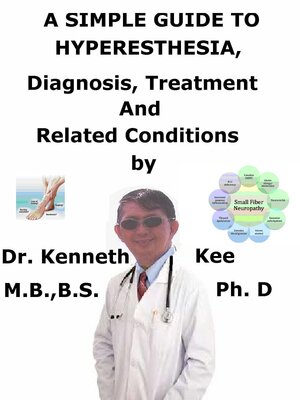
Sign up to save your library
With an OverDrive account, you can save your favorite libraries for at-a-glance information about availability. Find out more about OverDrive accounts.
Find this title in Libby, the library reading app by OverDrive.



Search for a digital library with this title
Title found at these libraries:
| Loading... |
This book describes Hyperesthesia, Diagnosis and Treatment and Related Diseases
Hyperesthesia indicates higher sensitivity of any of the senses, such as sight, sound, touch, and smell.
It can involve just one or all of the senses.
Often, the heightening of a single sense is indicated by a separate name.
The higher sensitivity to touch is called tactile sensitivity, and higher sensitivity to sound is called auditory sensitivity.
Hyper-algesia indicates higher pain sensations.
Hyperesthesia involves two different subcategories of improved pain sensation:
Hyper-algesia: A stimulus activates raised or extreme sensitivity to pain.
Allodynia: A stimulus that is not normally painful suddenly activates pain.
Hyperesthesia is an abnormal sensitivity to sensory stimuli, such as pain, sound, sight or touch.
Hyperesthesia indicates higher sensitivity to skin stimulation due to a decreased threshold or an increased reaction to stimuli.
Often depicted as a chronic burning type pain, it can also present as increased sensitivity to touch.
Types of hyperesthesia are:
Acoustic or auditory hyperesthesia: sensitivity to sound (Hyperacusis)
Gustatory hyperesthesia: sensitivity to taste (Hyperosmia)
Muscular hyperesthesia: sensitivity to pain or tiredness (Hyper-algesia)
Optic hyperesthesia: sensitivity to light (Photophobia)
Tactile hyperesthesia: sensitivity to touch (Sensory Defensiveness)
If painful hyperesthesia is the only symptom, the diagnosis of small-fiber neuropathy should be indicated.
In this type of neuropathy the sensory, often painful, symptoms start in the feet and progress proximally, ultimately affecting the hands.
Less normal start of symptoms has been reported in patients with revealed gain-of-function mutations of genes SCN 9A or SCN 10A, mutations present in some patients with this neuropathy.
Difficulties may happen when small-fiber neuropathy is diagnosed on the basis of skin biopsy.
In these circumstances it can be not clear whether loss of nerve fibers happens as a primary phenomenon or secondary to limb disuse in chronic pain.
The most frequent cause of hyperesthesia is peripheral neuropathy and there are more than 100 types of peripheral nerve disorders.
Diabetic nerve disorders,
Chemo-induced neuropathy,
Hereditary disorders,
Inflammatory infections,
Auto-immune diseases,
Protein abnormalities,
Exposure to toxic chemicals
Poor nutrition,
Kidney failure,
Chronic alcoholism,
Certain medicines given to treat cancer and HIV/AIDS.
Hyperesthesia symptoms often begin slowly and then become worse:
Numbness
Pain
Burning or tingling
Muscle weakness
Sensitivity to touch
A neurological evaluation, which comprises a number of simple and painless tests, is normally conducted to diagnose peripheral neuropathy:
Electro-diagnostic tests determine the electrical activity of muscles and nerves
Blood tests are often conducted to examine for vitamin deficiencies, toxic elements and abnormal immune response.
The doctor may advocate quantitative sensory testing and autonomic testing or other tests to diagnose a specific disorder
The treatment for hyperesthesia centers about treating the underlying cause.
If the patient feels that hyperesthesia is due to diabetic neuropathy, maintaining the blood glucose under control can help keep the disorder from getting worse
Treatments
Physical therapy
Cognitive behavioral therapy (CBT)
Medical Treatment
Pain relief
Intervention therapy
Tactile defensiveness






